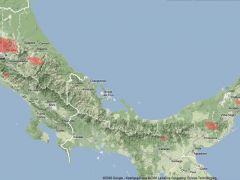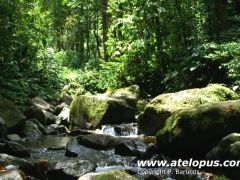Atelopus varius
Class Amphibia - Amphibians » order Anura » family Bufonidae - Toads - Duméril and Bibron, 1841
Atelopus varius - Lichtenstein & Martens, 1856
Size male: 25-41 mm.
Size female: 32-60 mm.
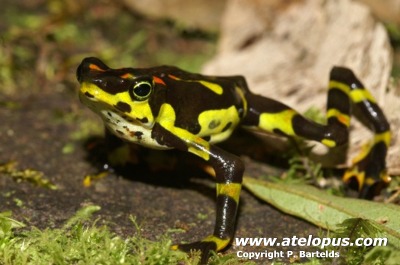
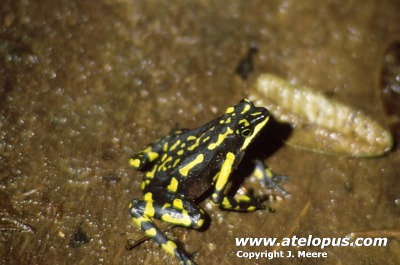
Atelopus varius - male. Population Alto de Piedra - Panama. Atelopus varius. Population Costa Rica.
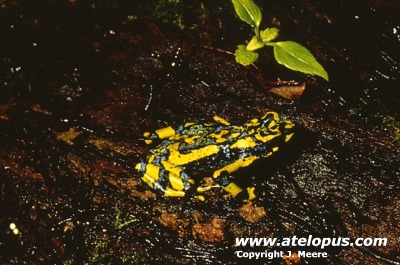
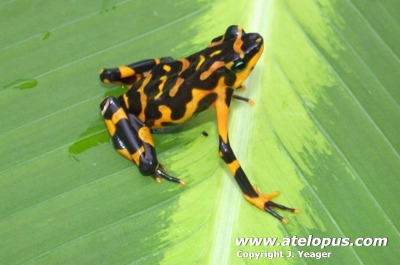
Atelopus varius. Population Costa Rica Atelopus varius. Population near Quepos - Costa Rica (Rediscovered 2005).
Geographic Range
Costa Rica and Panama. The historic range of A. varius is stretched from the Pacific and Atlantic slopes of the Cordilleras de Tilaran mountain range in Costa Rica into Western Panama. Suitable habitat includes both pre-montane and lower-montane zones as well as some lowland sites along rocky streams in hilly areas (ranging from 16 to 2000m in elevation) (Savage 1972). At present, A. varius is restricted to a single lowland site along a stream and small tributary on the Pacific coastal range near Quepos, Costa Rica (personal correspondence 2007).
Population
This species was declared extincted from Costa Rica during a couple of years, where one of the last places it could be found was in Cordillera de Tilaran near Monteverde nature reserve. During 1982-1983 there was an average of 751 adults along a 200 meter long section. The population was stable until the late 1980's. During 1990-1992 surveys where conducted in the area, but no animals where found in the area and it still remains absent from that area (Pounds and Crump 1985, 1987). Most of the populations have disapeared since 1988 and in 1996 scientists feared that all, over hundered populations known from Costa Rica, where totally wiped out. In 2003 a new population was discovered (Yeager & Cagliardo examined the population) in an area near Quepos after being feared extinct in Costa Rica during seven years. There has also been reports of a few small populations in Panama. Humans almost never see the extremely rare A. varius.
Coloration can vary a lot in this species even within the same population. Most populations are black with yellow coloration but it can differ from lime green to yellow and sometimes also appear with a few or more markings in orange or red on their dorsal side.
Habitat
This is a terrestrial species that has it's distribution over a wide range of altitutes and different types of tropical forest. Breeding and larval development takes place in forest streams. A. varius has been found at elevations ranging from 16 to 2000 meters, in zones characterized as tropical lowland/pre montane/lower montane. This habitat includes both dry and wet forest following small streamcs, where the seasonal weather pattern is divided into a wet (late May- to mid-November) and dry season (Savage 1972; Crump 1988).
Behavor
During daytime these frogs will be found sitting on rocks or logs around streams or in rock crevies. A. varius is a poor swimmer that rarely enters streams, and appears to depend on wetsurfaces in the splash zone for moisture.
The harlequin frogs seem to aggregate in waterfall splash zones with the progression of the dry season. At night it sleeps on top of large leaves in low vegitation above or near streams. Unlike the males of other Atelopus species males do not call females for breeding.
Males begin calling and defending territories at the onset of the wet season, and pairing begins 2 to 5 months later, from mid-August through early December(Pounds and Crump 1987; Crump 1988). The sex ratio is male-biased, and males often enter into amplexus early and remain with the female for as long as 32 days (Crump 1988). Females deposit eggs in the water from the end of the wet season to the early dry season, October to December (Pounds and Crump 1987).
Male-male antagonism is generally longer than female-female aggression and involves chirp-like advertisement calls and wrestling behaviour. Male aggression is increased both during the breeding season and in high density situations(Crump 1988). Female-female aggression lacks wrestling and calling. Generally it's less intense and less frequent and seems to be related to the defense of foraging and/or shelter sites (Crump 1988). Intersexual aggression is almost always female to male; females will chase, pounce on, and squash males who have invaded their territory and they will attack males whom they have dislodged from amplexus. The only hostile behaviour of males towards females is holding the amplectant position despite a females efforts to disengage. In a series of invasionexperiments, Crump (1988) demonstrated that territorial residents have the advantage in combat and higher success despite size differences.
Predators
The only known predator feeding on A. varius is the sarcophagid fly, Notochaeta bufonivora. The fly larviposits on the posterior surface of the frog's thigh,and the larvae subsequently burrow and feed within it, killing the frog within a matter of days (Pounds and Crump 1985, 1987).
Other interesting facts
For many years it was believed that A. zeteki probably was the same species as A. varius but there are a few known behaviours that differ between these species. For example male A. varius don't call females for breeding but A. zeteki does. Both species do wave to avoid fighting. This behavor has been filmed by a BBC filmcrew within A. zeteki in El Valle de Antón, Panama and can be watched under A. zeteki at this website.
Sources, references, more information & links
Press document - Rainmaker Conservation Project - Costa Rica.
Pounds, J., Puschendorf, R., Bolaños, F., Chaves, G., Crump, M., Solís, F., Ibáñez, R., Savage, J., Jaramillo, C., Fuenmayor, Q. & Lips, K. 2010. Atelopus varius. The IUCN Red List of Threatened Species. Version 2015.2. <www.iucnredlist.org>.
|
Class Amphibia - Amphibians » order Anura » family Bufonidae - Toads - Duméril and Bibron, 1841 Atelopus limosus - Ibáñez, Jaramillo & Solís, 1995 |
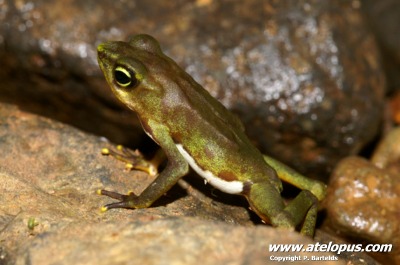 |
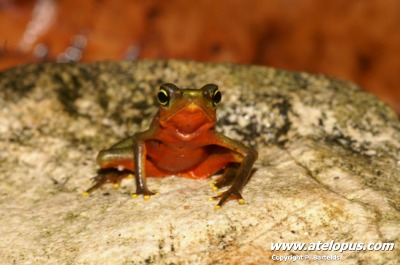 |
| Atelopus limosus - male. Population southern Portobelo. | Atelopus limosus - female. Population southern Portobelo. |
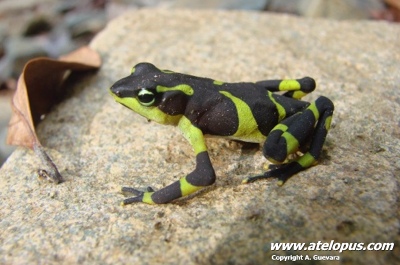 |
 |
| Atelopus limosus (varius?) - male. Population Kuna Yala area (mainland). | Atelopus limosus (varius?)- males. Population Kuna Yala area (mainland). |
